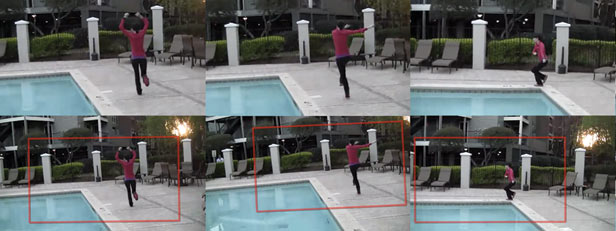

Intelligent Machines
Stabilizing Video
A new system cleans up shaky amateur footage.

Source: “Auto-Directed Video Stabilization with Robust L1 Optimal Camera Paths”
Matthias Grundmann et al.
Proceedings of the IEEE Conference on Computer Vision and Pattern Recognition, Colorado Springs, Colorado, June 21-23, 2011
Results: Google researchers have developed a technique that removes the effects of an unsteady filming hand on amateur video. After showing that they were able to smooth out footage in real time while maintaining focus on key elements in the image, they used their algorithm as the basis for a stabilizer application that runs in real time at www.youtube.com/editor. YouTube, the largest site used for sharing amateur video, did not previously have a stabilizing feature in its nine-month-old Web-based video editor.
Why it matters: Shaky footage has always been a mark of amateur filmmaking, since amateurs usually lack the costly equipment that professionals use to stabilize their cameras. Some algorithms are available to clean up this effect, but those typically remove jerking effects without correcting others, such as the slow bounce of a camera held by a person walking.
Methods: The algorithm begins by identifying key objects in the image and using them to plot the path traveled by the camera. It then determines a “best path,” which represents the smoothest course for the camera to have traveled. By cropping the frames, it is able to adjust the footage so that the camera appears to have traveled the best path. The algorithm uses tools such as face detection to make sure it doesn’t remove key components of the video in the process. Because the computational work is distributed among many machines, the system is fast enough for editing in a browser in real time.
Next Steps: Right now, the user has to specify what size the system should crop the frames to; the algorithms find the optimal path for the given size. In the future, the researchers plan to adjust the system so that it can calculate the ideal size on its own.
Faster Memory
Prototype phase-change memory drive is faster than conventional disks
Source: “Onyx: A Prototype Phase-Change Memory Storage Array”
Steven Swanson et al.
USENIX Workshop on Hot Topics in Storage and File Systems, Portland, Oregon, June 14, 2011
Results: A prototype disk drive built using phase-change memory chips, which store data in the crystal structure of a metal alloy, proved capable of both reading and writing some types of data faster than a commercial conventional flash drive. It was between 70 and 120 percent faster at writing chunks of data the size of a short text-only e-mail.
Why it matters: Phase-change memory has the potential to overcome a limitation that has constrained computer design for decades: data can’t be written to or read from disk storage nearly as fast as a processor can work on it. This new type of memory has only recently been incorporated into prototype chips; using them to build a working disk drive demonstrates how this technology might help improve computers and clarifies the remaining barriers to commercialization.
Methods: Researchers at the University of California, San Diego, built the prototype using phase-change chips made by Micron, a company working to commercialize the technology. The chips record digital 1s and 0s by using small bursts of heat to flip the arrangement of atoms in an alloy made from elements called halcogenides between an ordered lattice and an amorphous phase. The researchers built those chips into circuit boards that usually hold conventional memory chips. They also added circuits to translate between the computer’s requests and the stored data.
Next Steps: The researchers are using their prototype drive to understand how significantly speedier data storage could lead to more powerful computer designs.